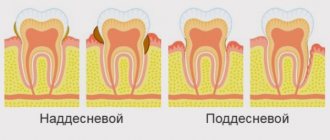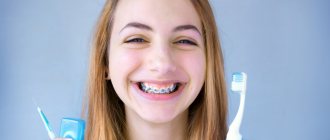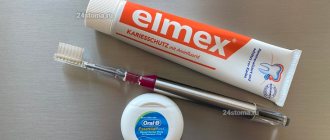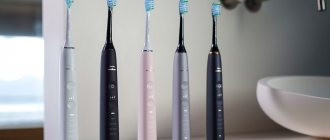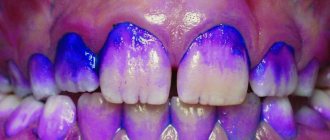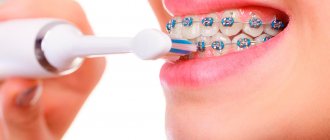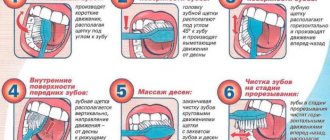Why do you need to brush your teeth?
Oral hygiene is not only a matter of aesthetics. It is due to medical reasons. A plaque constantly forms on the enamel, consisting of: • food particles; • saliva; • waste products of microorganisms inhabiting the oral cavity.
The process of plaque deposition does not depend on whether a person ate in the interval between brushings. If it is not removed, over time it turns to stone. Contamination not only creates a cosmetic defect. Deposits contribute to the violation of the integrity of the enamel. Pathogenic bacteria penetrate into the resulting cracks and actively multiply under conditions of poor hygiene. This is how caries begins with all the known consequences. These microorganisms also attack the gums. In people who neglect to brush their teeth, gingivitis becomes chronic. If the inflammation is not treated, complications in the form of periodontitis and periodontal disease are possible. As a result, the root no longer holds in the socket and the tooth falls out.
How effective is this method?
After a week of using salt to cleanse the mouth, you can notice the first result .
Keep in mind! The effect of use is the following changes:
- gums stop bleeding;
- the enamel becomes a little lighter ;
- bad breath disappears .
Salt is a good antiseptic, so it can be used to prepare a rinse solution.
Despite the fact that this cleaning method is quite effective, you should consult a specialist before using it, as this procedure has its drawbacks.
How to brush your teeth correctly?
It is a mistaken idea that everyone can do this. There are a number of rules, many of which are either unknown or ignored. However, only compliance with them guarantees effective cleaning of the enamel: • Carrying out hygiene procedures not only at home, but also at the dentist. • Rational selection of brushes and paste. • Using the optimal teeth brushing method. • Using dental floss, brushes and mouthwash. • Taking into account the condition of the gums, the presence of braces and dentures. • Compliance with the rules for storing, cleaning and replacing brushes.
Tablets for determining plaque will help you understand whether you have achieved your goal. They demonstrate whether unwanted deposits are present on the enamel. They also suggest which areas are not being worked through carefully enough.
Choosing a toothbrush
To completely clean the enamel from plaque, you need to choose a suitable brush. The easiest way to do this is by material. There are two options here - natural and synthetic. It is better to give preference to the latter, since they are quite elastic, and the tips of the hairs are usually rounded, which is safer for the gums. Bacteria multiply faster on natural materials.
In terms of the stiffness of the bristles, toothbrushes are: • Soft. They are best taken for children, adolescents and people suffering from gingivitis. • Average. A universal option for people without dental problems. • Tough. They help fight hard plaque and can be used only when indicated.
The configuration of the bristles should be discussed with your dentist. It will tell you where more sediment collects. For example, if you need to better work on the necks of teeth, bristles collected in bunches can handle this.
Pasta selection
Pastes are hygienic, preventive and therapeutic. The first ones solve the only problem - clean the enamel. The latter, due to the antiseptic component, help prevent the development of gingivitis and caries. Still others are prescribed by dentists for therapeutic purposes; it is better not to use them on your own.
Toothpastes are also distinguished according to the results of use: • whitening - slightly lighten the enamel, but you should not expect drastic changes from them; • strengthening – contain fluoride, good for enamel health; • desensitizing - reduce sensitivity; • anti-inflammatory - help with gingivitis.
Abrasiveness characterizes the degree of impact on plaque. The average value of this indicator is from 50 to 80. Higher values can be taken occasionally to lighten teeth. Lower abrasiveness is indicated for sensitive enamel and gums.
Recipes with salt
Based on this product, you can prepare a medicinal paste with the addition of dried banana skins, olive oil and pine needle extract.
Such a cleaning composition will not only remove plaque and clean the oral cavity, but also strengthen the structure of the roots.
You should take into account the fact that banana skins can be chemically treated, and this will not benefit the body.
To get rid of stone and plaque complications, it is recommended to use a composition based on:
- salt;
- eucalyptus leaves;
- olive oil.
Keep in mind! Combining heated sea salt with crushed eggplant gives a good effect.
This mixture should be applied to the teeth and gums; it helps get rid of many dental diseases.
To increase blood circulation and treat periodontal disease, you can use a mixture of salt with clay and ground red pepper.
Due to the fact that salt is a completely natural product, it
can be mixed with various herbs and other natural ingredients.
You can make homemade pasta using salt. The calcium tablet must be crushed into powder and mixed with the main component.
Water is gradually added to the resulting mixture until it becomes a paste. You can add a small amount of regular paste.
When cleaning with this product, you need to be very careful so as not to injure your gums.
Proper brushing of teeth: sequence of movements
For hygiene purposes, you need to accustom yourself to a certain sequence of movements.
After squeezing the paste onto the brush, you must: • apply it to the teeth at an angle of 45 or 90 degrees; • pass each one 3-4 times in the direction from the gums to the cutting edge; • treat chewing surfaces with circular movements; • Allow at least 30 seconds of brushing for each half of the jaw. Depending on the location of the brush and the direction of movement, there are three methods of brushing teeth. The most famous (90 degree brush, top to bottom movements) is the Leonard method.
The Bass method involves choosing an angle of 45 degrees and making vibrating movements. It is good because the bristles penetrate into the interdental spaces and partially work out the contact surfaces. With the Fones method, an angle of 90 degrees is taken and the brush moves in a circle. This further massages the gums, which improves blood circulation and protects against inflammatory processes.
What's the harm?
If you do not follow the cleaning technology, you can harm your tooth enamel.
You should know! If you press too hard on your toothbrush, you can damage the enamel and cause pain in your gums.
Frequent salt cleansing can lead to thinning of the top layer of teeth.
If tooth enamel is damaged, brushing your teeth with salt or salt-based paste can cause pain.
Additional oral cleansing
Oral hygiene is not limited to two rows of teeth. For complete cleansing it is necessary to treat: • Interdental spaces. Dental floss or a brush will help remove plaque. • Language. To do this, use the relief surface of the back of the toothbrush or a special scraper. • Gums. They are partly cleaned with a brush: at an angle of 45 degrees, the bristles approach the edge and capture deposits. Rinse aid also helps. • Cheeks. You can go over them with the back of the brush, but they require more rinsing.
You need to start by removing the largest food debris. To do this, just rinse your mouth with water. Then comes the turn of fragments stuck in the interdental spaces - this is where floss comes to the rescue. Now you can take up the brush with the paste. Rinse aid is used last - to create a protective layer.
Classic application
Sea salt is better suited for this recipe, as it is rich in iodine. But you can use cookware. In any case, select fine salt, otherwise you will have to additionally crush it in a coffee grinder.
Cleaning scheme No. 1:
- wash your hands with soap;
- sprinkle salt on your fingers;
- Gently rub the surfaces on all sides.
Cleaning scheme No. 2:
- put a little salt on your tongue;
- wipe teeth from the outside and inside;
- rinse your mouth.
During the first procedures, painful sensations will appear. But after 3-4 cleanings they will go away.
How to brush your teeth with gingivitis?
Inflammation of soft tissues is not a reason to neglect hygiene. On the contrary, the more often cleansing is done, the less chance bacteria have to support the inflammatory process.
However, you need to take precautions: • choose brushes with soft bristles (preferably rounded); • choose a paste with low abrasiveness and containing medicinal herbs; • give preference to the Bass method, and abstain from the Fones method until remission; • move your hand more carefully to avoid painful sensations.
Cleaning time should not be shortened, even if the procedure causes discomfort. Sometimes dentists even recommend increasing it. Inflammation of the gums is accompanied by the formation of pockets. Where their edges lag behind, stone grows with particular intensity. This place deserves more careful study.
How to clean dental structures?
Dental structures in the mouth make adjustments to the cleaning process: • Crowns. More attention should be paid to the area where the gums come into contact with the prosthesis. • Bridges. A round mono-tuft brush is more suitable for them. • Veneers. The teeth where they are installed cannot be treated with floss. The ban does not apply to other methods. • Braces. The space under the arch and the area adjacent to the enamel is cleaned with brushes.
In all of the above cases, it is necessary to use an irrigator. Conventional cleaning devices are not able to penetrate all the places where plaque accumulates. There are no barriers for water. Under the pressure set by the device, it knocks out stuck food fragments, preventing them from decomposing or turning into stone.
How do plaque tablets work?
We usually contact a dentist to assess the quality of oral hygiene. It identifies areas that are not cleaned effectively and makes recommendations for replacing the paste or brush. But in between visits to the clinic, you can cope without the help of a doctor.
Special tablets, developed by the Swiss company CURADEN, will help with this. They are part of the CURAPROX range of dental care products. Determination of plaque occurs as follows: • the tablet is diluted in water; • after brushing, a person rinses his mouth with this solution, distributing it over his teeth; • deposits are stained, clean enamel remains intact.
The tablets also help distinguish soft plaque from tartar. The first one becomes pink, the second one becomes dark blue. This way you can understand whether it’s time to go for ultrasonic cleaning.
Reviews
Below are some reviews. If you have something to say, leave your feedback in the comments below the article, it will be useful to our readers.
Valeria
I have been periodically brushing my teeth with salt for six months now. First I mixed it with paste. The doctor advised using salt for cleansing no more than once a week.
After such cleanings, I noticed that the enamel became whiter, and the teeth themselves were less sensitive to cold and hot.
The doctor also advised periodically using a saline solution to rinse the mouth.
Sofia
I have long wanted to try salt brushing, but I was afraid that it could harm tooth enamel.
Before carrying it out, I consulted with a doctor, he recommended not to get carried away with this procedure and under no circumstances combine such a product with soda or lemon juice.
The first time I brushed my teeth with salt and a small amount of toothpaste. Over time, I just switched to salt gruel. I carry out this procedure several times a week.
Consequences of not brushing your teeth properly
Proper and timely cleaning of dental plaque is protection against oral diseases.
If you neglect it, the consequences will only increase: • Tartar forms. It gives off an unpleasant odor. If you do not carry out ultrasonic cleaning, it will become a favorite place for bacteria. • Bacteria will destroy the enamel. The abundance of pathogenic microorganisms quickly leads to caries. • Bacteria will cause your gums to become inflamed. Soft tissues are no less sensitive to them than hard ones. And this means bleeding, swelling and an unpleasant odor.
Possible complications are also worth mentioning. Caries develops into pulpitis, which requires removal of the nerve. This deprives the tooth of nutrition, as a result of which it sooner or later collapses. Progressive gingivitis is fraught with periodontitis and periodontal disease. Lack of oral hygiene leads to tooth loss. Restoring them is more expensive than the cost of a brush, paste and professional cleaning. Therefore, it is better to remember these simple rules and follow them.
Efficiency
Salt prevents bacteria from multiplying. Disinfects the mucous membrane, washes away germs, penetrating even the smallest cracks and cracks, and disinfects the oral cavity. Cleans surfaces thanks to abrasive particles. Lightens enamel by 2-3 tones. Contains beneficial microelements and does not cause allergic reactions or side effects even if swallowed.
As a result of processing, pure salt crystals are obtained
To remove plaque, use sea salt in combination with baking soda.

